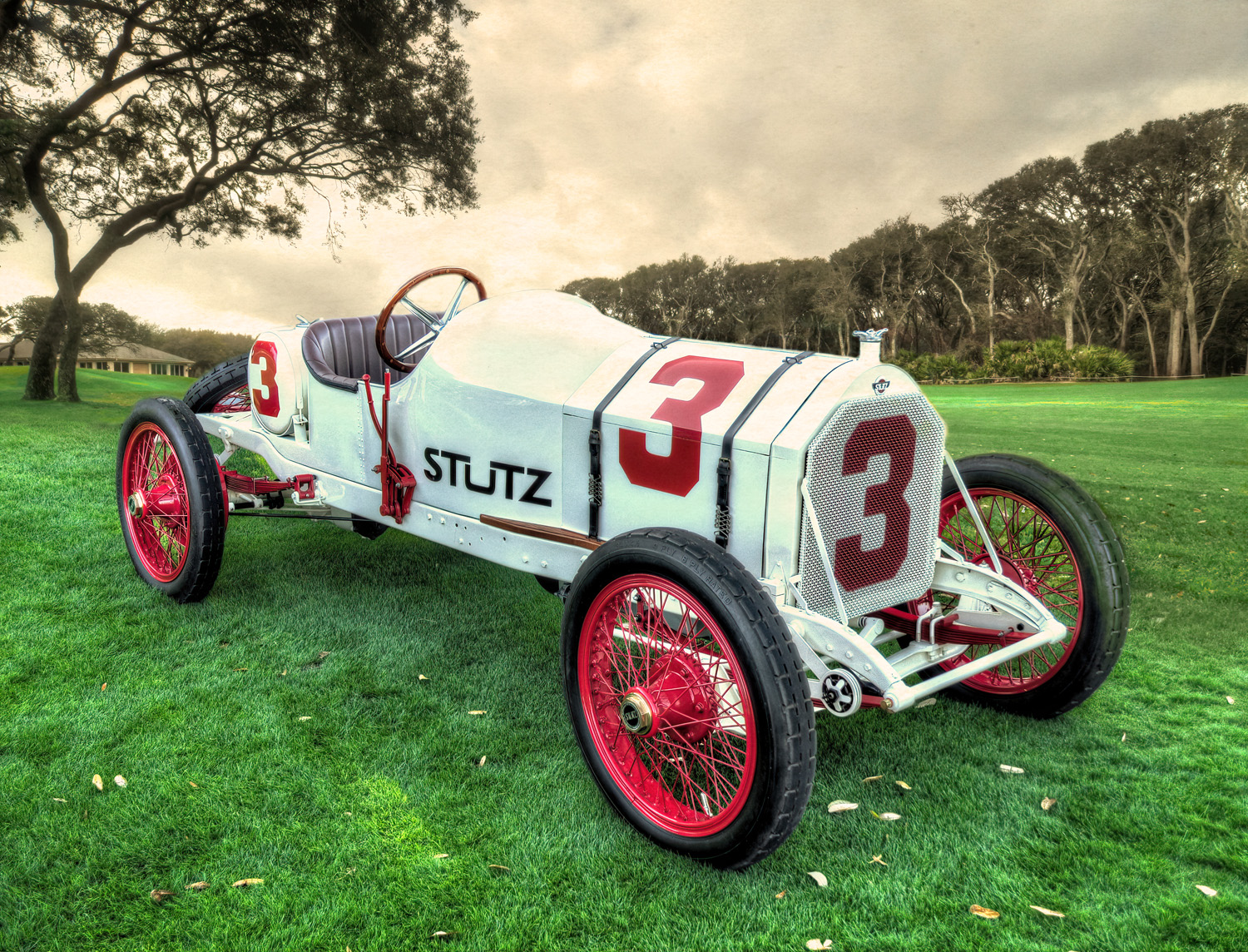
Three Stutz Race cars entered the 1914 Indianapolis 500, and the #3 was driven by Barney Oldfield. The 1914 Stutz Indy Race Car was Oldfield’s first attempt and he finished fifth, taking home $3,000 for his efforts. The Stutz was powered by a 434 cubic-inch, four cylinder Wisconsin engine as Stutz did not produce engines until 1917. The vehicle was shipped to California and raced until it fell apart, which was the case with most race cars of that era. The engine is known to have thrown a rod on the #3 cylinder. The Wisconsin engine in the current #3 indicates it also had a rod break on the #3 cylinder as evidenced by a chunk of block missing in the #3 area. This current #3 with the 434 cubic inch Wisconsin and Stutz Bearcat frame and chassis, is an exact copy of the one that raced at Indy.
The 1914 Stutz Indy Race Car is a testament to early automotive innovation and the competitive spirit of the Stutz Motor Car Company. Its powerful engine, streamlined design, and robust construction made it a formidable contender in racing events like the Indianapolis 500. The Stutz Indy Race Car remains a cherished and celebrated vehicle among vintage racing enthusiasts and collectors, ensuring its place as one of the most iconic and revered models in the history of American motorsport.
Overview
- Production Year: 1914
- Manufacturer: Stutz Motor Car Company
- Model: Indy Race Car
- Body Style: Open-wheel race car
Design and Specifications
- Engine:
- The 1914 Stutz Indy Race Car is powered by a 4-cylinder T-head engine.
- The engine displacement is approximately 5.9 liters (361 cubic inches).
- It produces around 80 horsepower, which was impressive for the time.
- Transmission:
- The car is equipped with a 4-speed manual transmission.
- The gearbox is designed to provide optimal gear ratios for both acceleration and top speed on the racing circuit.
- Chassis:
- The chassis is constructed from sturdy steel, providing a balance of strength and lightweight design.
- The wheelbase is relatively long for stability at high speeds.
- Suspension:
- The front suspension consists of a solid axle with semi-elliptic leaf springs.
- The rear suspension also features a solid axle with semi-elliptic leaf springs.
- This setup provides a combination of durability and handling performance.
- Brakes:
- The Stutz Indy Race Car is equipped with mechanical drum brakes.
- These brakes offer adequate stopping power, essential for the high-speed nature of racing.
Performance
- Top Speed: The Stutz Indy Race Car could achieve top speeds of around 80-90 mph (129-145 km/h), which was competitive for the era.
- Acceleration: The powerful 4-cylinder engine provides strong acceleration, making the car capable of quick starts and maintaining high speeds on straights.
- Handling: The lightweight chassis and well-tuned suspension offer good handling and maneuverability, crucial for success on the challenging Indianapolis Motor Speedway.
Design Features
- Bodywork:
- The body of the race car is designed for aerodynamics and weight reduction.
- It features an open-wheel design with minimal body panels to reduce drag and weight.
- The body is typically made from aluminum or other lightweight materials.
- Interior:
- The interior is spartan, focused on functionality and driver ergonomics.
- The driver's seat is a single bucket-style seat, providing support during high-speed driving.
- The dashboard includes essential gauges and controls, positioned for easy access during races.
- Styling:
- The styling of the Stutz Indy Race Car is characterized by its sleek, purposeful design with racing livery and sponsor logos.
- Its distinctive appearance and bold graphics make it a standout on the track.
Legacy and Historical Significance
- Historical Significance:
- The 1914 Stutz Indy Race Car represents an important era in American motorsport history, showcasing the technological advancements and competitive spirit of early 20th-century racing.
- It highlights Harry C. Stutz's contributions to automotive engineering and motorsport.
- Racing Success:
- Stutz race cars were known for their performance and reliability, often competing in prestigious racing events like the Indianapolis 500.
- The 1914 Stutz Indy Race Car performed admirably at the Indy 500, demonstrating the brand's engineering prowess.
Purchase a Print of the 1914 Stutz Indy Race Car Online here.
The Vintage Automobile Article Index


